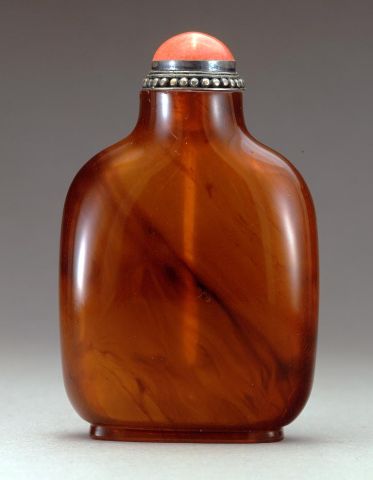
Bottle ID: 182
PLAIN WITH DARK STRIATIONS
Date: 1750-1850
Height: 72 mm
Amber, of transparent rich brown color with darker striations, very well hollowed, of flattened, rectangular form with shoulders sloping to a cylindrical neck and wide, oval recessed foot, the swirling striations mainly on one side and disposed as a diagonal pattern within the material.
Possibly imperial, attributed to the Palace Workshops.
Similar Examples:
Moss, Hugh, Victor Graham and Ka Bo Tsang. A Treasury of Chinese Snuff Bottles - The Mary and George Bloch Collection, Vol.7, Part 1, pp. 277-278, no. 1574.
Stevens, Bob C. The Collector's Book of Snuff Bottles, 1976, p. 176, no. 685.
Kleiner, Robert. Treasures from the Sanctum of Enlightened Respect. Chinese Snuff Bottles from the Collection of Denis Low, 1999, pp. 248-249, no. 213.
Provenance:
Hugh Moss [HK] Ltd.
Much of the most highly-prized amber is transparent, in contrast to the very common cloudy amber and opaque amber. The main source of this type of amber known as ‘jinbo’ was Burma. Opaque amber contains numerous minute bubbles which, according to their density and size, make the amber more or less opaque. This kind of amber is known as found in the Baltic region and is referred to as either “Baltic amber” or at times by gemologists as "bony amber". Amber was an easy material to carve, however it is clear why the carver left this bottle undecorated. The material is a beautiful color with intriguing darker swirls throughout the body and it is easy to imagine swirling incense as it is held in the hand and appreciated for the tactile quality that amber had. Its shape is a typical mid Qing form that appeared in the Palace Workshops in materials such as jade, coral and amber.
< Back to full list

 English
English 中文
中文